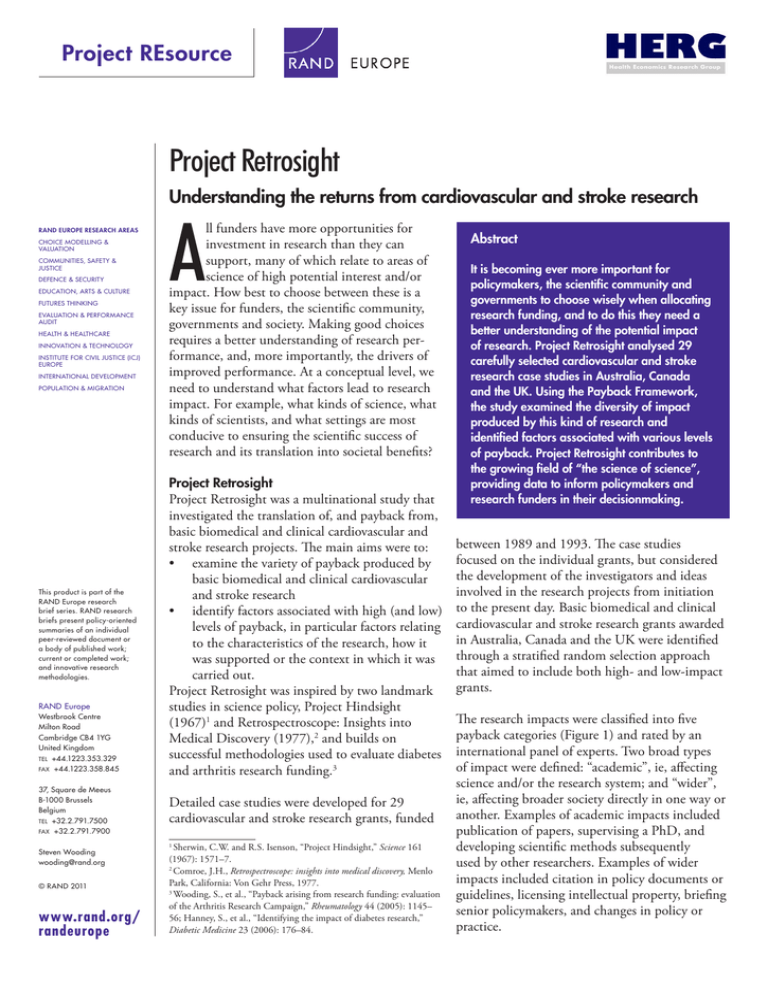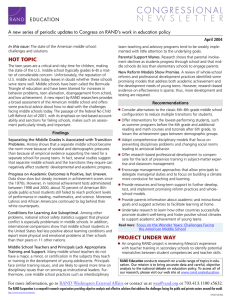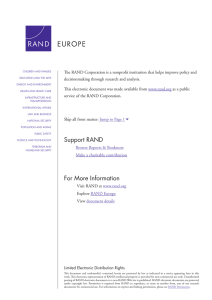A Project Retrosight Project REsource Understanding the returns from cardiovascular and stroke research
advertisement

Project REsource Project Retrosight Understanding the returns from cardiovascular and stroke research RAND EUROPE RESEARCH AREAS CHOICE MODELLING & VALUATION COMMUNITIES, SAFETY & JUSTICE DEFENCE & SECURITY EDUCATION, ARTS & CULTURE FUTURES THINKING EVALUATION & PERFORMANCE AUDIT HEALTH & HEALTHCARE INNOVATION & TECHNOLOGY INSTITUTE FOR CIVIL JUSTICE (ICJ) EUROPE INTERNATIONAL DEVELOPMENT POPULATION & MIGRATION This product is part of the RAND Europe research brief series. RAND research briefs present policy-oriented summaries of an individual peer-reviewed document or a body of published work; current or completed work; and innovative research methodologies. RAND Europe Westbrook Centre Milton Road Cambridge CB4 1YG United Kingdom TEL +44.1223.353.329 FAX +44.1223.358.845 37, Square de Meeus B-1000 Brussels Belgium TEL +32.2.791.7500 FAX +32.2.791.7900 Steven Wooding wooding@rand.org © RAND 2011 www.rand.org/ randeurope A ll funders have more opportunities for investment in research than they can support, many of which relate to areas of science of high potential interest and/or impact. How best to choose between these is a key issue for funders, the scientific community, governments and society. Making good choices requires a better understanding of research performance, and, more importantly, the drivers of improved performance. At a conceptual level, we need to understand what factors lead to research impact. For example, what kinds of science, what kinds of scientists, and what settings are most conducive to ensuring the scientific success of research and its translation into societal benefits? Project Retrosight Project Retrosight was a multinational study that investigated the translation of, and payback from, basic biomedical and clinical cardiovascular and stroke research projects. The main aims were to: • examine the variety of payback produced by basic biomedical and clinical cardiovascular and stroke research • identify factors associated with high (and low) levels of payback, in particular factors relating to the characteristics of the research, how it was supported or the context in which it was carried out. Project Retrosight was inspired by two landmark studies in science policy, Project Hindsight (1967)1 and Retrospectroscope: Insights into Medical Discovery (1977),2 and builds on successful methodologies used to evaluate diabetes and arthritis research funding.3 Detailed case studies were developed for 29 cardiovascular and stroke research grants, funded Sherwin, C.W. and R.S. Isenson, “Project Hindsight,” Science 161 (1967): 1571–7. 2 Comroe, J.H., Retrospectroscope: insights into medical discovery, Menlo Park, California: Von Gehr Press, 1977. 3 Wooding, S., et al., “Payback arising from research funding: evaluation of the Arthritis Research Campaign,” Rheumatology 44 (2005): 1145– 56; Hanney, S., et al., “Identifying the impact of diabetes research,” Diabetic Medicine 23 (2006): 176–84. 1 Abstract It is becoming ever more important for policymakers, the scientific community and governments to choose wisely when allocating research funding, and to do this they need a better understanding of the potential impact of research. Project Retrosight analysed 29 carefully selected cardiovascular and stroke research case studies in Australia, Canada and the UK. Using the Payback Framework, the study examined the diversity of impact produced by this kind of research and identified factors associated with various levels of payback. Project Retrosight contributes to the growing field of “the science of science”, providing data to inform policymakers and research funders in their decisionmaking. between 1989 and 1993. The case studies focused on the individual grants, but considered the development of the investigators and ideas involved in the research projects from initiation to the present day. Basic biomedical and clinical cardiovascular and stroke research grants awarded in Australia, Canada and the UK were identified through a stratified random selection approach that aimed to include both high- and low-impact grants. The research impacts were classified into five payback categories (Figure 1) and rated by an international panel of experts. Two broad types of impact were defined: “academic”, ie, affecting science and/or the research system; and “wider”, ie, affecting broader society directly in one way or another. Examples of academic impacts included publication of papers, supervising a PhD, and developing scientific methods subsequently used by other researchers. Examples of wider impacts included citation in policy documents or guidelines, licensing intellectual property, briefing senior policymakers, and changes in policy or practice. -2- Figure 1 Payback categories and impact groupings Payback categories Impact groupings Knowledge production Academic impacts Research targeting and capacity building Informing policy and product development Health and health sector benefits Wider impacts Broader economic benefits Key findings and policy implications The five key findings from the study are: The cases reveal that a significant number and diverse range of impacts arise from the 29 grants studied There is a considerable range of research paybacks associated with the grants studied, and many of these would not have been identified without the structured, case study approach used in this study. This resonates with the diversity of payback identified in the earlier study on arthritis research. Examples of payback include: • A project on the determinants of increased growth of vascular smooth muscle in spontaneously hypertensive rats resulted in 16 articles (including a paper in the prestigious Journal of Clinical Investigation) that have received 849 citations • A project on the role of coagulation and fibrinolysis in the pathogenesis of recurrent stroke led to two PhDs, an MD and development of a patient cohort and control group that formed the basis of a stream of work and helped the PI establish his research group • A project analysing the results of the Heartstart Scotland initiative to introduce automated defibrillators into all Scotland’s ambulances is widely cited in guidelines and informed policy of ambulance services in Scotland and England • A project studying the follow-up to heart attacks contributed to a major international project on health promotion, which in turn contributed to a decline in coronary heart disease in the region • A commercial transgenic facility was developed as a result of the animal models for myocardial dysfunction and is now a multi-million dollar business that exports 80 percent of its services. There are variations between the impacts from basic biomedical and clinical research Basic biomedical research has a greater academic impact and clinical research a greater wider impact over the timescales investigated (Figure 2). All of the grants studied had academic impact, but the average rating was higher in basic biomedical research than in clinical research. Over the 15- to 20-year timescale of this study, for the combined wider impact categories all clinical studies had some impact, compared to only six out of 15 basic biomedical case studies. It is possible, however, that basic biomedical research would have a larger wider impact than clinical research over a longer timescale. Figure 2 Impact means 6 Mean rating 5 Basic Clinical 4 3 2 1 0 KP RTCB IPPD HHSB Payback category BEB -3- Figure 3 Correlation between the wider impact payback categories and knowledge production 9 ρ = 0.112 ρ = 0.424 Informing policy and product development Informing policy and product Researchdevelopment targeting and capacity building 8 9 7 8 6 7 5 6 4 5 3 4 2 3 1 2 0 1 0 0 9 1 0 3 Informing policy and product development Health and health sector benefits Broader economic benefits 9 8 4 5 6 7 Knowledge production 3 4 5 6 1 2 7 Knowledge production 10 = 0.106 0.424 2 9 8 9 ρ = 0.036 9 ρ = 0.106 ρ = 0.112 8 8 7 8 7 4 3 9 1 0 1 3 0 1 2 3 4 5 6 7 Broader economic benefits 8 9 Knowledge production 1 1 2 2 3 3 4 4 5 5 6 6 Knowledge production Knowledge production 7 7 10 0.106 8 8 9 9 4 5 6 7 8 9 ρ = 0.036 9 6 5 4 1 2 0 1 0 0 1 2 3 4 5 6 7 8 9 Knowledge production Case studies ρ = 0.036 9 We can identify factors associated with high and low impact We have identified a number of factors in cardiovascular stroke research that are associated with higher and lower academic and wider impacts. These factors are listed in Figure 5 overleaf, along with an associated policy implication for research funders and policymakers to consider – the evidence supporting each factor is described in detail in the full report. 8 7 6 5 4 3 2 1 0 9 3 2 3 0 0 2 4 2 0 0 9 9 5 2 1 2 1 10 6 4 3 3 0 Figure 4 Knowledge production Economic impact distribution 7 7 6 5 5 4 6 majority of economic impacts identified come from a The minority of projects 5 Only four of the 29 case studies reported substantial broader 4 economic benefits and 19 grants had no broad economic 3 impact (Figure 4). It is important that these distributional 2 effects are understood in any assessment of research impact. The 1 majority of economic impacts tend to come from a small proportion of projects. 0 8 8 7 6 6 5 7 Broader economic benefits Broader economic benefits ρ = 0.424 production’ and the three wider categories, ‘informing policy and product development’, ‘health and health sector benefits’ and ‘broader economic benefits’ (Figure 3). This has implications for debates about both research commissioning and assessment. From a policy perspective this would suggest 9 ρ = 0.112 that the level of knowledge production is not a good predictor 8 of wider impacts. 0 1 2 3 4 5 6 7 8 9 Knowledge production There is no correlation between knowledge production and wider impacts Some of the individual projects were rated highly for both knowledge production and wider impacts, but overall there is little correlation between the payback category ‘knowledge Just as science is the effort to discover and increase human understanding of how the world works and how we can influence it, science policy should be about understanding how the world of science works and how we can influence it to maximise benefits for society. Studies like Project Retrosight contribute to the growing field of ‘the science of science’, providing an evidence base to inform research funders in their decisionmaking, and helping to identify areas that need further analysis. -4- Table S.2 Figure 5 Factors associated high- and low-impact research Factors associated with high-with and low-impact research, and their policy implications Factor Policy implication Basic biomedical research with a clear clinical motivation is associated with high academic and wider impacts When seeking to achieve high academic and wider impacts, encourage and support clinically motivated basic biomedical research Co-location of basic biomedical research in a clinical setting is associated with high wider impact When seeking to achieve high wider impacts from basic biomedical research, encourage and support the colocation of basic biomedical researchers with clinicians in a clinical setting (e.g. a teaching hospital or health organisation) Strategic thinking by clinical researchers is associated with high wider impact When seeking to achieve high wider impacts from clinical research, focus clinical research funding on PIs or teams who think strategically about translation into clinical practice Research collaboration is associated with high academic and wider impact When seeking to achieve high academic and wider impacts, encourage and support research collaboration for both basic biomedical and clinical research International collaboration is associated with high academic impact When seeking to achieve high academic impact, encourage and support international collaboration for both basic biomedical and clinical research Engagement with practitioners and patients is associated with high academic and wider impacts When seeking to achieve high academic and wider impacts, encourage and support clinical researchers who have a record of engaging with practitioners and patients Basic biomedical research collaboration with industry is associated with high academic and wider impacts When seeking to achieve high academic and wider impacts from basic biomedical research, encourage and support collaboration with industry Negative or null findings are associated with low academic and wider impacts Research funders should acknowledge the importance and potential significance of negative or null findings when assessing the impact of research Initial rejection of a subsequently accepted basic biomedical research grant may be associated with low academic and wider impacts Further research is needed to confirm whether initial rejection of a research proposal is associated with low impact. Until this finding can be confirmed or refuted, funders may want to carefully consider such proposals Further Reading • Wooding, S., S. Hanney, Pollitt, A., M. Buxton, J. Grant. Project Retrosight. Understanding the returns from cardiovascular and stroke research: Policy Report. Cambridge, UK: RAND Europe, MG-1079-RS, 2011. • Pollitt, A., S. Wooding, S. Hanney, M. Buxton, J. Grant. Project Retrosight. Understanding the returns from cardiovascular and stroke research: Methodology Report. Cambridge, UK: RAND Europe, TR-925-RS, 2011. • Buxton, M., and S. Hanney. “How can payback from health services research be assessed?” Journal of Health Services Research and Policy, 1 (1996):35-43. • Grant, J., and S. Wooding. In search of the HolyGrail: understanding research success. Cambridge, UK: RAND Europe, OP-295-GBF, 2010. RAND Europe is an independent not-for-profit research institute whose mission is to help improve policy and decision-making through research and analysis. RAND Europe’s publications do not necessarily reflect the opinions of its research clients and sponsors. R® is a registered trademark. RAND Offices Santa Monica, CA • Washington, DC • Pittsburgh, PA • New Orleans, LA/Jackson, MS • Boston, MA • Doha, QA • Abu Dhabi, AE • Cambridge, UK • Brussels, BE RB-9573-RS (2011) CHILDREN AND FAMILIES EDUCATION AND THE ARTS The RAND Corporation is a nonprofit institution that helps improve policy and decisionmaking through research and analysis. ENERGY AND ENVIRONMENT HEALTH AND HEALTH CARE INFRASTRUCTURE AND TRANSPORTATION This electronic document was made available from www.rand.org as a public service of the RAND Corporation. INTERNATIONAL AFFAIRS LAW AND BUSINESS NATIONAL SECURITY POPULATION AND AGING PUBLIC SAFETY SCIENCE AND TECHNOLOGY TERRORISM AND HOMELAND SECURITY Support RAND Browse Reports & Bookstore Make a charitable contribution For More Information Visit RAND at www.rand.org Explore RAND Europe View document details Research Brief This product is part of the RAND Corporation research brief series. RAND research briefs present policy-oriented summaries of individual published, peer-reviewed documents or of a body of published work. Limited Electronic Distribution Rights This document and trademark(s) contained herein are protected by law as indicated in a notice appearing later in this work. This electronic representation of RAND intellectual property is provided for non-commercial use only. Unauthorized posting of RAND electronic documents to a non-RAND Web site is prohibited. RAND electronic documents are protected under copyright law. Permission is required from RAND to reproduce, or reuse in another form, any of our research documents for commercial use. For information on reprint and linking permissions, please see RAND Permissions.






